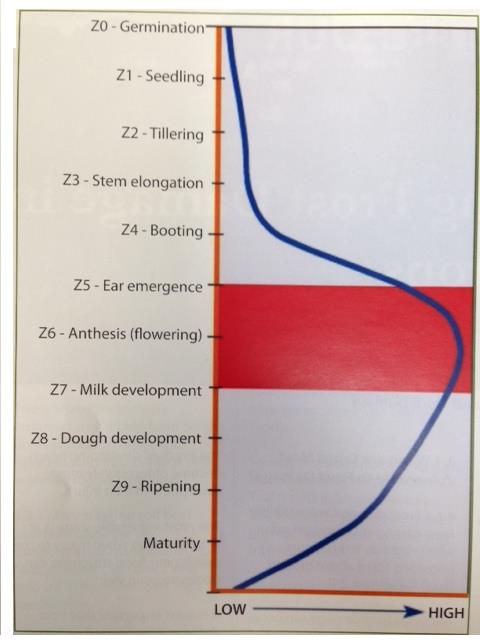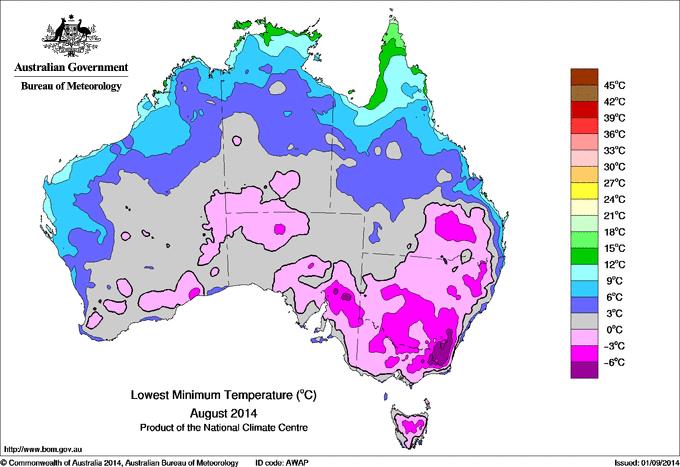Managing the catastrophes – for example; frost, BWYV, pests
Author: Tim McClelland and Harm van Rees | Date: 18 Sep 2014
Tim McClelland1 and Harm van Rees2,
1BCG, 2Cropfacts.
Keywords: risk, decision support tools, catastrophic events, frost, BWYV, pests.
Take home messages
- You can’t plan for a catastrophic event but you can spread your risk so as to minimise its affect.
- No single strategy will alleviate the risk associated with a catastrophic event so multiple solutions are required.
- When confronted with a catastrophic event, growers will be in a state of shock. Decision support tools can be useful for focussing the attention on what can be done to salvage the situations.
Farming is a risky enterprise with great uncertainty about our production and profitability from season to season. Australia has one of the most variable climates on earth which means that we are exposed to great variation in yield. Australian farmers are generally very good at managing this variation. However, when a sudden shock is put into the equation our systems for managing variation are put to the test.
Recent events; frost and disease in the grain production regions of south eastern Australia have tested our resolve for managing catastrophes. A catastrophe is a sudden and widespread disaster. In farming the potential causes of a catastrophe are numerous. In a cropping context our potential returns can be severely affected by external factors over which we have no control. Some examples of these are:
- Frost.
- Heat shock.
- Disease (BWYV, rust, crown rot, etc).
- Pests (mice, locusts, etc).
- Rain at harvest.
- Grain prices collapse.
You can’t plan for a catastrophic event but you can spread your risk so as to minimise its affect. A catastrophe is usually outside the realms of our experience making it impossible to plan for. That said, for each of the examples listed above there are hedges or management practices that can be implemented so as to minimise the effect that these shocks may have on overall profitability. While this paper and presentation will focus on frost and heat shock the principles applied in this example can be applied for all potential catastrophes that can affect us on farm.
Cereal crops are most susceptible to frost injury during and after flowering, and may also be susceptible at booting. Losses in grain yield and quality from frost primarily occurs between stem elongation and late grain filling (Rebbeck and Knell, 2007). We are used to dealing with frost injury at flowering, because it occurs frequently, but we are less accustomed to losses resulting from frost straight after tillering. As is evident from Figure 1 the susceptibility of crops is very low during this period. Thus growers have had limited experience with dealing with stem frost and frost outside the flowering and grain development period.

Figure 1. Wheat susceptibility to frost damage (Source: DAFWA ‘Cereals Frost ID – the Back Pocket Guide’).
The minimum temperatures experienced during 2014 were very unusual. It is evident from Figure 2 and Figure 3 that at Horsham some of the lowest temperatures ever recorded during August occurred in 2014. Is this going to become more prevalent?
Climate change is likely to result in: (i) changing rainfall patterns – the trend in rainfall is getting drier, especially during the time of peak water use in spring when crops flower and fill grain (ii) warmer temperatures – average daily temperatures have increased. This means more rapid crop growth and earlier flowering. Higher CO2 levels are also increasing crop growth (iii) hot days – the number of hot days (temperatures over 30oC) seems to have increased during spring, when crops are stressed for moisture, this results in flower abortion and reduced ability to fill grain (iv) frosts – the frost pattern seems to have changed. Frosts are more frequent, occur earlier and continue later in the season. Dry conditions and frosts are features of our highly variable climate that have to be managed to the best of our abilities. What can we do to minimise the effect of such an extreme event?

Figure 2. Australia’s lowest minimum temperatures (°C) recorded during August between 1950 and 2005.

Figure 3. Australia’s lowest minimum temperature (°C) recorded during August 2014.
There are two approaches to minimising the effect of a catastrophe: prevention or cure. We have all heard the expression that prevention is better than cure. In a frost context we can’t really prevent the effect of a catastrophic event but we can reduce its affect and this has to be done at the start of the season.
Crop phenology is the study of the life cycle of crops and how it is influenced by seasonal variations in climate. The maturity of cereal crops is controlled by their response to average daily temperatures (thermal time), but this is moderated by day length (photoperiod) and cold requirement (vernalisation). Different wheat and barley varieties have different genetic sensitivity to photoperiod and vernalisation. All cereal varieties accumulate heat (thermal time) in order to grow. For example, wheat varieties grown in our region develop a new leaf every 100 degree days. A degree day is achieved when the average daily temperature for a number of days adds up to 100 degrees, during which, the wheat plant will have formed a new leaf. Photoperiod is the plant’s response to day length (hours of daylight).
Lengthening days induce the plant to speed up the rate of change from vegetative to reproductive development (from growing leaves to the development of flowering organs). Vernalisation occurs when a plant is subjected to low temperatures for a specific time. When the vernalisation requirement has been reached, the plant speeds up the rate of change from vegetative to reproductive development. True ‘winter’ types require a long vernalisation period before they develop into their reproductive phase (for example Rosella wheat). Most ‘spring’ types of wheat have little or no requirement for a cold period and will continue to grow and develop throughout the season (for example Catalina wheat).
Opportunities to sow early arise when there is sufficient moisture in the soil to germinate and grow crops in April. Sowing early can reduce our risk exposure to dry conditions during spring but increases our exposure to frost damage during flowering and grain-filling. With the widespread adoption of no‐till seeding, in which weeds are controlled before and at sowing with contact and residual herbicides, many crops are now sown by the calendar, regardless of whether it has rained or not. An increasing number of farmers begin sowing in mid‐April. Early sown crops are at risk from frost damage during flowering, and late sown crops are at risk of dry conditions and heat shock events during the grain filling period. Frost can kill flowering florets while heat shock reduces starch accumulation during grain‐filling, resulting in a lower yield and reduced grain quality.
One management practice to reduce the risk of frost damage is to sow a couple of paddocks with a longer season wheat first, followed by a couple of paddocks with a shorter season wheat, followed by the longer season wheat and so on. This will ensure that not all the wheat sown flowers in the same week, which would make the whole program susceptible to a frost. Another management practice with a similar outcome could be to mix varieties of different seasonal length and sow them both early and late in the sowing window. The two varieties will develop at different rates, reducing the potential impact of a frost.
It can be difficult to identify the frost and heat shock risk for different wheat varieties at different sowing dates and at different locations. There are a number of decision support tools that can help in this regard which can found using a search engine. One example of these is Yield Prophet®. Yield Prophet has a sowing opportunity report which allows users to assess the optimal sowing date for most wheat varieties for maximising yield potential and the associated frost and heat shock risk at any location in Australia. Figure 4 is showing three example outputs for three varieties sown at Horsham.

Figure 4. Yield Prophet Sowing Opportunity Report outputs for Mace, Phantom and Bolac wheat at Horsham showing the optimal sowing date for maximising yield potential and the associated frost and heat shock risk.
What about cure? Many crops in 2014 have been severely affected by frost which has significantly reduced grain yield potential. Growers must consider how they might best salvage some income from these affected crops by: (i) taking the crop through to harvest for grain, (ii) cutting the crop for hay or (iii) using livestock to graze the crop and convert the crop biomass into meat or wool. This decision is not always easy. There are positives and negatives associated with all three options. Growers must weigh up the risks associated with each and must assess the return potential possible.
In agriculture there are decision support tools for almost every decision we have to make. Many growers do not use tools to help them make decisions, relying wholly on their experience and intuition. In the majority of cases, this approach works very well and will often give the desired result. However, often intuition can be adversely affected by past experiences, particularly recent ones, or biased by external factors. Decision support tools can help to correct biases in intuition. When confronted with catastrophic event growers will be in a state of shock. Decision support tools can be useful for focussing the attention on what can be done to salvage the situations.
Catastrophic events will continue to occur in the future. Good businesses will utilize both preventative and curative strategies to minimize the effect of these events. They will diversify their risk by implementing a range of varieties/crop types, etc or management practices and in the event of a catastrophic event they will adapt and respond quickly to minimize the effect of the event.
References
M Rebbeck and G Knell, 2007, Managing Frost Risk A Guide for Southern Australian Grains Grans Research and Development Corporation Canberra ACT.
Contact details
Tim McClelland
Was this page helpful?
YOUR FEEDBACK
